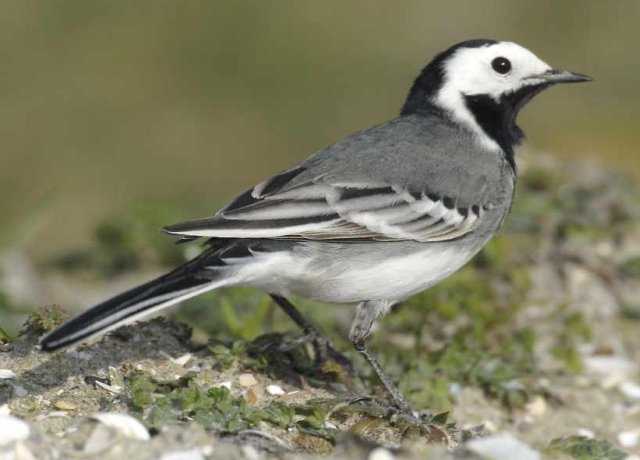White Wagtail

White Wagtail
NL: Witte kwikstaart
D: Bachstelze
F: Bergeronnette grise
Latin name: Motacilla alba (Linnaeus, 1758)
Bird group: Pipits and wagtails
Sound: Call ’tissik’, less sharp than Great Yellow Wagtail. Sing indistinct chatter, mixed with shouting.
Field characteristics: 18 cm. Smaller than Greater Yellow Wagtail, larger than Yellow Wagtail, without yellow. In summer plumage crown, chin and breast black, forehead, face and cheeks white, upper parts gray, wings black and white, parts white, long tail black with white outer feathers. In winter plumage face much whiter, black reduced to narrow breast band. Male has more black on crown than female and black is also more sharply separated in neck. Walks, bounces constantly with long tail. Juvenile browner, without the characteristic head pattern of the adult and with a narrow breast band, as an adult in winter plumage. Flight strongly undulating. In breeding season in pairs, sometimes breeds in a colony-like setting. Outside the breeding season alone or in separate groups, but then sleeps in joint sleeping places with tens to many thousands of birds. The above plumage description applies to subspecies alba of continent. British subspecies Wagtail yarrellii (sometimes seen as a separate species) has completely black upperparts, black or dark gray flanks and broader white wing stripes; female lighter but always with more gray on flanks than alba and with blacker back and rump and dark flanks. Always gray in alba, but this is often difficult to see in the field.
Appearance: Numerous breeding bird and present all year round, but summer visitor in Scandinavia and Central Europe.
Habitat: Occurs in all kinds of habitats, often close to human habitation. Usually in areas with open spaces and low vegetation, such as fields, suburbs of cities, parks, etc. Often near water.
Food: Mainly insects and other small invertebrates. Hunts on the ground, runs after prey and often flies short distances to catch prey in the air.
Song/call:

